High Peaks Pure Earth presents English translations of short posts by ten young Tibetan writers and their views on the state of modern Tibetan literature. These views were originally published in Tibetan on WeChat on May 11, 2020. Below is a short introduction by the translator Riga and do not miss the extensive footnotes. Thank you for translating this important discussion!
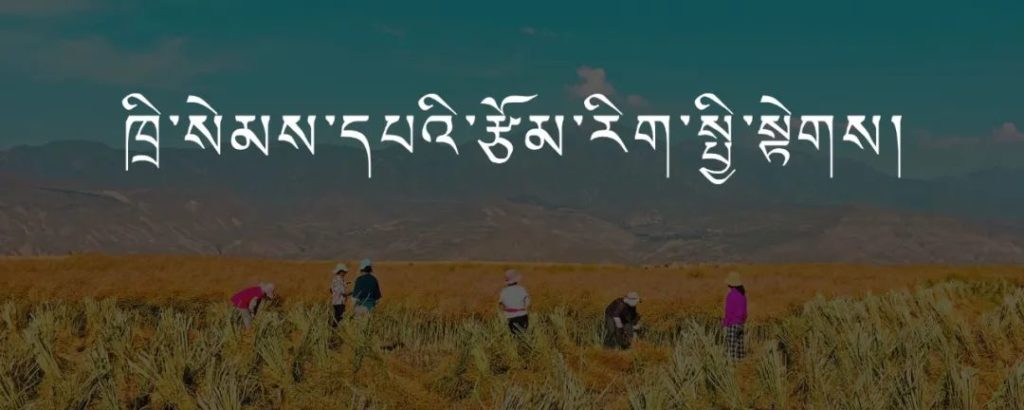
Young Tibetan Writers Discuss the State of Modern Tibetan Literature
This important discussion the on the state of modern Tibetan literature by ten young Tibetan writers appeared on the Tri Semba Literary Blog (khri sems dpa’i rtsom rig spyi stegs), a popular public account on WeChat, on May 11, 2020. Some of the writers have published prolifically and have won awards, and as such will be well known to readers. Others are relatively obscure, and their works appear primarily online and in regional journals. As with most conversations by writers on writing, comments can range from cutting to perceptive to infuriating. They are all however, valuable. In my translation I have tried to be faithful to the tone of each individual writer, while making the English as accessible as possible to the general reader. My accompanying notes have been included for specialist readers, and they may betray some of my own unsolicited thoughts on the subject. Riga
What is the state of modern Tibetan literature?
Editor’s note: Some say that modern Tibetan literature is more or less comparable to contemporary world literature[1]. Others say that modern Tibetan literature pales in comparison. Truth be told, it’s safe to say that most of us debating these issues are “writers” without any works to our name, not individuals who are dedicated flesh and bone to the production of literature. Considering the situation, I have invited a number of young writers who have diligently committed themselves to modern Tibetan literature to discuss the state of the field. I hope that such a conversation might shed some light on the place of modern Tibetan literature in contemporary society. I pray that in future years, writers will continue to exert themselves in creating innovative literature and that powerful works may flow from their pens.
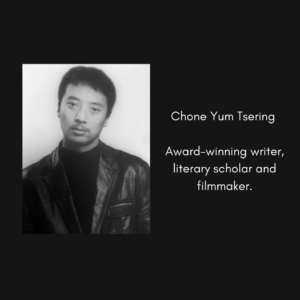
Chone Yum Tsering
While in general modern Tibetan literature might be understood to refer to poetry, essays, articles, narrative fiction, to me, it is a contentious subject. As I have some familiarity with the area, my comments will be focused on narrative fiction[2]. If we consider both Tibetans inside and outside Tibet, we can say there are three primary language mediums: Tibetan, Chinese and English. And though we can divide Tibetans writing narrative fiction into three general language groups, despite a large number engaged in academic research, there are very few Tibetans writing English language fiction. Therefore, in terms of numbers, this English language group is relatively insignificant, and we can say there are two main groups, namely those writing in Tibetan and those writing in Chinese. Since the 1980’s [3]there have been a large number of Tibetan language fiction writers, however, many of these writers have day jobs in other fields. Some writers have attempted to transcend literary conventions. Those writing in Chinese and other languages may have excelled in producing new works; yet, fundamentally, we depend on those writers producing literature in our mother tongue. Over the last few years many works of fiction have been published, and many literary groups have been established by the government and privately. In terms of quality, I’ll quote Professor Dulha Gyal, “although later generations of writers are producing works more innovative than their predecessors, our writers are not without fault.”[4]
I have three points I’d like to discuss. The majority of fiction writers are part-time writers, to whom literature remains merely a passion, not a livelihood. And therefore, one’s own capacity, ability, power, position, wealth, worldly affectations and personal joys and sorrows cannot be put aside. All great writers, inside and outside the country, have the courage to offer their minds and bodies to literature, as well as the aspiration to give up everything for literature. The offerings of our own writers however, have been paltry and it is clear they have neither the aspiration or vision to sacrifice for literature. Second, while a writer may be prone to spontaneous inspiration [5], their work would not be possible without the foundation of knowledge: the act of reading itself. As a writer, completing a new work and being published are temporary goals. What is then, the relationship between the published author and reading? Just because a writer has published many books it is not fair to say that they have done much reading themselves. Many of our writers do not read very much, it is as if they are meditating on emptiness and have erected a palace of illusions in their consciousness. This sort of spontaneous and experiential approach might be suitable for poetry; however, fiction requires one to be versed in many fields of knowledge and in local customs. Attempting to represent in detail, the myriad kinds of pregnant feelings that characterize the chaos that is life, a writer without good reading habits of his own is just like a person climbing a cliff-face without any arms. The end goal of reading is to gain a systematic understanding of knowledge, and to cultivate an independent aesthetic and philosophy. This is something we should strive for. At some points of my life, I produced heaps of pages without much reading or thinking. This is something I regret deeply.
Thirdly, as conditioned [6] human beings, we are the embodiment of the world’s religious traditions. While it is only natural to praise what you like, and disparage what you don’t, these days with the rise of internet literature, many writers are staring at computer screens with wide eyes and raised ears in the pursuit of empty fame. While writers are usually a serious and solemn bunch, they seem to be unable to loosen from their singled pointed concentration and appreciate the literary devices [7] of others in the past. Our writers have a shallow knowledge of their own intellectual tradition, and so, their writing has no perceptible quality of its own. The realm of literature as I see it, cannot be created in this way. And so, some writers privilege literary devices and narrative techniques leaving the real world behind. Many others, privilege the plot , and persist in narrative literature with no room for artistic experimentation. This of course pertains to literary theory, and I cannot provide adequate analysis and commentary in a few words. In conclusion, our fiction in terms of plot, lacks detail and is underdeveloped, remaining therefore, artistically uncompelling. In terms of narrative technique, we might turn to the saying: one hundred songs played to the same tune. Simply put there is nothing innovative going on. When it comes to meaning, the works are unrestrained and all over the place, failing to capture the chaos of society or plumb the depths of the human mind.
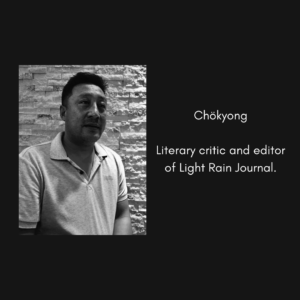
Chökyong
Looking at the state of modern Tibetan literature from the perspective of Light Rain journal[8], and from my own point of view a reader, there is good reason to be happy. Even if certain forms of literature[9] may have their own specific issues, generally speaking, I don’t see there being any contradiction in my making such a statement. Why? Consider the progress that has been made in and is continuing to be made in the development of modern Tibetan literature, from its first unsteady steps, to the ‘unhindered and faultless’ stage we are in now. That said however, we must be resigned to the fact that at this moment both our oral and written traditions are on the precipice.
Therefore, even if modern Tibetan literature has only an history of just over thirty years, it is indubitable that its fruits are of great magnitude and boundless in number. It is clear especially that reaching the cusp of this epoch, in terms of meaning and style, that such tremendous progress has been made that it rivals the waxing of the moon. I have written about this subject in my book, A Chaotic Arrangement [10], and so I won’t expand here.
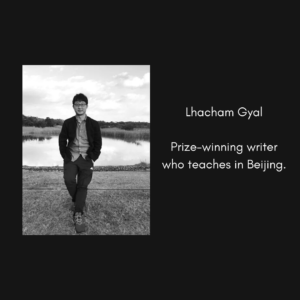
Lhacham Gyal
If I were to tell you that there is no falsehood in literature, you might say doubtfully that literature is born of the imagination and therefore cannot possibly have any truth in it. To this I would say that in your answer you are thinking only of the story in the literary work of the author. It has nothing to do with my statement about there being no falsehood in literature. What I am talking about is the capacity of a literary work to capture the capacity of public sentiment, the sharpness of sensation, the richness of imagination, the symbolic power of language and the innate characteristics of a people. Literature serves to show that a culture can stand independently, that living conditions have reached a certain level and that there is courage in the hearts of people and so on. All of these different manifestations are what I am talking about. And so, in literature it is all of these above aspects that take form, flowing from the pens of the many writers of a specific people. So, generally speaking, these writers and their works may on occasion, by the power of fate, transcend the conditions of their environment. However, this kind of innovation is difficult if it is not part of a general progress in the conditions of a people. Literature therefore, has no falsehood about it. It is not false to say that a people’s literature provides a general measure of a people. And even more so, it is not false to say that it is difficult for there to be innovation in a place devoid of progress and advancement.
And perhaps by considering this situation we might find an appropriate and fitting answer to the prompt: What is the state of modern Tibetan literature? It naturally becomes a messy discussion on the general situation of the Tibetan people. The issue of Tibetan modern literature is one in which the state of Tibetan language, culture and society are all entangled. In all aspects: ripe but not yet mature; not preserved and developed well enough; confused and not stable in itself; hindered and obstructed; thoughtless and hollow; fickle and impatient; conceited and self-important. In short, it is unquestionable that the tiresome affectations of modern Tibetan society have also afflicted modern Tibetan literature like a virus. Some don’t want to admit to this. Especially those self-titled writers who act as if they believe they have transcended the very Tibetan society that actually gives them such a title. Maybe they are just so full of themselves that they want to act like their shit doesn’t stink. Let me tell you again there is no falsehood in literature. Hold the books in your hands and take a good look. How far away we are from the truth of literature is self-evident! But we must realize that the key to overcoming this distance is also in our hands. More still, the general state of Tibet is something we must continue to realize for ourselves.
In conclusion, we are wanderers on the path who have not yet reached their final destination. What we need is not the clamoring sounds of victory or the self-satisfied waving of red flags. What we need is the discipline of the wanderer; silent, perspiring, patient in the face of loneliness, taking measured steps, each one leading us further and further ahead. It is on such a path that the truth of literature becomes possible. It is on such a path that the glorious triumph of modern Tibet literature is certain.
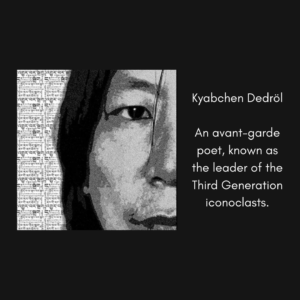
Kyabchen Dedröl
I don’t see the state of modern Tibetan literature as a particularly good one. The road ahead I don’t see as being bright or lustrous as some others might do. However, these reasons haven’t caused writers to lose their courage and confidence. Many writers have cast away myth and legend and turned instead to reality. In my writing, I try to depict the human world in its most ugly; dreadful; contemptuous; terrifying manifestations. In unadulterated and subconscious form, this is what belies the outer husk of our world. If we were to broaden our minds, we may term this ‘the world that forks off from the river of the sensory’. We might be writing new myths and legends in a search of the essence of this generation, but in terms of the language and the conventions of literature, we are failing to innovate. Moreover, if we continue to be beguiled by mellifluous rhetoric and besotted with wordplay, modern Tibetan literature will fail to deserve the descriptor modern. Whatever your measure of literature might be, literature rests upon the thoughts or consciousness of the writer. Don’t all these aesthetes just come across as verbose and fatuous?

Re Kangling
Looking back, what we call modern literature is a general term for forms of writing associated with Western modernism. And from this borrowed term, we can say that modern literature is generally concerned with subverting the general conventions of expression and traditional forms of realist literature and characterization. In doing so, modern literature focuses on the subjective, sensory world of the writer and privileges capturing the realm of the psyche in words. However, in face of the progress of history, and changes in aesthetic values, the scope of the term modern becomes too broad, almost limitless. I think that it’s impossible to point to a certain work and call it modern literature!
Broadly speaking we can say that what we call modern Tibetan literature has a history that spans the period of the 1980’s to the present day. But if we are to probe a little deeper, the field of the modern as doctrine has very little in terms of defining features; be it in terms of expression or subject matter. In the field of Sinophone literature, we have a magical realist work like Tashi Dawa’s A Soul in Bondage, and correspondingly among Tibetan works we have work like Jangbu’s A Soul Born from a Shoulder Blade[11]. Works like these however, are few in number, and apart from those in literary circles, they have not made a lasting influence on the general reader. So, what we call modern Tibetan literature, I think we can say has in terms of ideology endeavored to reject the traditional literary narratives of the Tale of the Incomparable Prince, and the metrical verse of Kavyadarsa poetry[12]. At the beginning of the 21st century, developments in information media and the increased democratization of technology, have meant that mediums such as film have become increasingly popular. This means the modern quality of literature becomes problematic. However, in the words of one of the great poets of the modern tradition, Baudelaire, “You gave me your mud and I have turned it into fiction” [13]. If we take this statement as one of the foundations of modern literature, we can see that many stories have been created out of the lives of ordinary Tibetans families and characters. The overturning of parochial tradition through the celebration of figures such as prostitutes and widows in poetry, is also representative of the essence of the modern.
However, in recent years, many works of Chinese and global literature have been translated into Tibetan. There has been a global turn in the structure and narrative techniques of our short stories, and the imagery and so on, of our poetry. Global literature as a broader field has influenced Tibetan writers, and has been and continues to be a new source of inspiration for the development of our literary tradition. A Tibetan writer therefore has the right to experiment with narrative techniques and literary theory. But in the spirit of universal progress, racist or sexist works are inexcusable. The modern is an aggregate comprised of a universal mindset that in the Chinese context has resulted in the removal of some of Lu Xun’s articles for textbooks, perhaps one day, those glittering ‘good sayings’ will be displaced by foolish and menacing words[14]. Can we call that modern literature of our time?

Akyab Dargye
Firstly, in terms of the writer, the deficient quality and lack of ability is a serious issue. Especially, deficiency in terms of knowledge of literary theory. Many might express a love for literature, but it is mostly performative. Because of all this, on the modern Tibetan literary stage, writers who pursue literature with one heart and one mind are like stars in the day sky. There are few young writers. And among these young writers, those who can write a novel are even fewer.
Secondly, the quality of the works themselves is lacking. Since its inception, modern Tibetan literature has produced few excellent works that are world class, endowed with the characteristics of a people, rich in cultural essence and written in an aesthetically pleasing style. Even if Tibetan works are compared with works in the national context, we have no works that are close to being winners of the Mao Dun Literature Prize or the Lu Xun Literary Prize.
Thirdly, from the perspective of the reader, there are few readers with a real love of literature. Young readers are even fewer. We lack the great societal environment to even appraise a great work of literature.

Gangnyon
Describing the state of modern Tibetan literature is like describing the coat of a black and white horse, or the wool of a spotted sheep. It’s messy, chaotic, full of good and bad, all in one. I can’t say definitely that this is this and that is that, so it’s a difficult subject to address. In very general terms, we have reached an age where we are not faced with a lack of Tibetan literature, but a lack of quality; that much at least is clear for everyone to see.
The reasons for this lack I see as such. In previous times, writers were hard to come by in society. Out of a hundred people there may be only one or two. Therefore, for an ordinary person to become a writer, they would have to study diligently and bear great suffering. It was impossible for them not to pay a great toll in blood and sweat. To be more specific, first one would have to study grammar and spelling comprehensively. Without a good apprehension of these fundamentals one would have no hope of understanding the grammatical structures of the Buddhist philosophical treatises. Secondly, one would have to master the art of composition and metrical poetry. Without this you would struggle to decipher complex rhetorical language. Thirdly, without a deep understanding of the many volumes of Tibetan cultural sciences, you would have only a rudimentary understanding of Tibetan texts. Without any of this, in all aspects, be it in terms of a philosophical view of the world or an experiential understanding of life, an ordinary individual would have no hope of becoming a writer.
However, these days, forget about poor spelling and compositions skills, anybody who can write the alphabet is a writer. With only a shallow understanding of the nature of things, and bereft of any skills in wordplay, anybody who records their scattered thoughts is a poet. Despite having poor linguistic skills and not being able to apprehend the deeper meaning of words in two different languages, anybody with a basic comprehension of two languages is a translator. Not only this, but all who enjoy criticizing and slandering others are recognized as literary critics and cultural commentators. So, in this way, we consider anybody who sets down a few words a writer. In this world, the job of the writer, I see as not being a particularly easy one. All corners of the land of snows are full with writers; but in terms of depth and quality we have fallen into a sharp decline, that is the true state of modern Tibetan literature.
The work of writing is part of the deep Buddhist instruction on knowing one and liberating all[15]. Writers today on the other hand, see one side but remain blind to all others, like a blind yak grazing. Poetry – rich with the power to touch the hearts of the people through a stream of thought and consciousness – is today reduced to indecipherable rhetoric, as if offering your fears and anxieties to the sun or lighting a bale of hay on fire. Criticism should be an honest and impartial analysis of a work, uncorrupted by biased contentions. But these days critics are driven by their whims and caprices, making belittling and disparaging comments wantonly as if throwing stones at a jackdaw nest. In sum, intellectuals these days, whether young or old, are full of conceit and so convinced of the righteousness of whatever faulty views they hold. I’m on top of the world, they think to themselves, I’m a master of fiction and king of theory, he’s better than you and I’m better than him. All they do is act haughty and pretentious and amongst themselves. Apart from sharing some rudimentary understanding of a work, they fail to broaden their minds and honour diverse intellectual views. Those who can truly approach the objective and subjective conditions and make constructive criticism are few in number. And even so, some while knowing better, might still make pretentious comments. “He is what you might call an authentic man of letters. You are not. That’s a real intellectual. The others are far from it. Him, well he is a scholar who has grasped the depths of the four stages of life, the vicissitudes of time and the beginning and end of all things!” Most common is when somebody makes some earnest comments and then another comes along and plays contrarian out of jealousy. Some might carry these unhappy expressions and insincere thoughts to the end of their lives. These kinds of hurtful comments are pointless. Just as a wolf eats flesh and a rabbit eats grass, it will always be difficult to distinguish between who is right and who is wrong. Ultimately it is up to the individual to take responsibility for themselves. If we can put our individual squabbles aside and produce some quality works of criticism, we can set an example to the new generations of readers, and take responsibility for Tibetan literature. I think that should be enough for now.
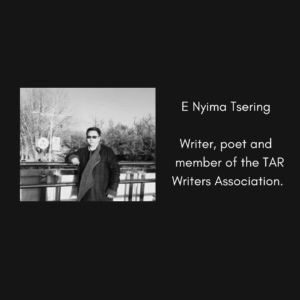
E Nyima Tsering
Regarding the state or literature today, I would say there’s a lot to be happy about and there’s a lot to be disappointed by. On a positive note, through the medium of the internet, we see writers and discussions of literature everywhere. But at the same time, there are some disturbing developments that go hand in hand with this phenomenon. That is to say, anybody who picks up a pen now proclaims themselves a writer; and anybody who jots down a few verses titles themselves a poet. I can’t help recall the saying ‘making a medley of fish and turnip’[16]. These developments have had a negative impact on nurturing top writers and appreciating high quality works of literature. Since early times, literature has been a marker of progress and the triumph of knowledge akin to a hat on a head, or a jewel atop of a crown. Fault lines have begun to appear in the unadulterated realm nature of literature. The red wind of internet literature has the butter lamp flame of print literature quivering[17].
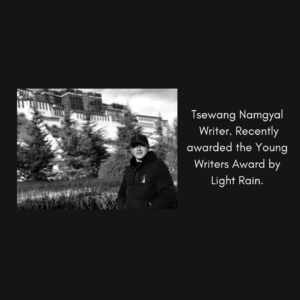
Tsewang Namgyal
I’ve heard it said that with regard to the novelist Traba[18], some academics remark derisively: “Traba? You mean that novelist?” And that in some intellectual circles they sigh with exasperation and say “Oh Lhacham Gyal, you’re still writing novels? Isn’t it time for you to publish a research article?” If you ask me about the state of modern Tibetan literature, I would say that is the state of modern Tibetan literature today. The literary movements of the late 20th century have now subsided. We have become seduced by new forms of communication, and by academic research. At current, it appears as if Tibetans don’t love literature enough. If we were to look at cultural centers and universities, let’s take for example an average Tibetan language and literature class, out of forty students only a handful have a real interest in literature. This I believe any contemporary university student would attest to. Even if a few out of the majority engage with literature, when they later graduate and join society, whatever literary aspirations they have eventually disappear. Aren’t they just like a poor shepherd on the mountain pass or a destitute elderly neighbor? Anybody can see there is not much value ascribed to modern literature in contemporary society. I believe this is an issue that needs to be addressed. If I were to go on, this issue could be seen to be part of our own intellectual tradition. For Tibetans, the study of the Buddhist scriptures and conventional sciences, is a field that has not declined from earlier times. At the beginning of the 13th century Sakya Pandita may have deemed Tibetans ill-suited to (Kavya) poetry, but the poetic tradition has continued to flourish today, like sesame oil from a heap of sesame seeds. On another point, I think that it in the literary world of the undervalued field of modern Tibetan literature, it is difficult for luminaries like Kafka, Borges, Camus, Dostoevsky, Joyce, Sartre and Marx to arise. Perhaps it is unlikely to have literary works like The Castle; The Stranger; The Brothers Karamazov or One Hundred Years of Solitude, come out of a cultural field that has a history of less than half a century? For one, it’s possible that it isn’t the right time for works like these to be produced. However, at this time, when all forms of art are in stagnation, there are those still committed to literature all over the Tibetan plateau. This I see as a very good situation. The literary trend of the previous generation has abated. This period of time where literature is undervalued as a cultural field I view as a good opportunity to take literature seriously. Furthermore, I take pride in the fact that contemporary writers are the very individuals who are active in taking literature seriously.
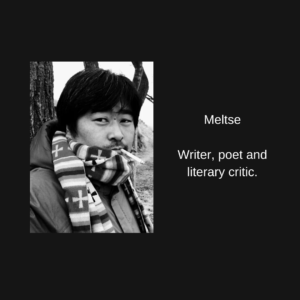
Meltse
If I were asked to describe the state of modern Tibetan literature, I certainly have a lot to say. But if I pause for a moment, a lot of that analysis is colored by what I perceive as faults and strengths in individual contemporary works. That certainly won’t do.
A general consideration of the history of modern Tibetan literature would distinguish between periods of the founding of the People’s Republic of China and the institution of reforms under the Open Door Policy. We might also call these two distinct time periods, the ‘Peaceful Liberation’ period and the “Religious Revitalization” period. Whatever we call these periods, it clear that people in these times had their own way of understanding the world [19] informed by a specific political consciousness. Therefore, from the literary perspective, how the nature of literature itself was understood, and whether or not an aesthetic sensibility was truly established, is a matter still to be debated. Moreover, in terms of reference point, our understanding of our own literary history has been shaped by Chinese literary history. The prevailing Chinese notion of literary history is characterized by the May 4 notion that the history of mankind is a cycle of development and progress. You can see the influence of Darwinian developmentalism here. And so, informed by this kind of thinking, we proclaim involuntarily, “the Tibetan literature of today is the most beautiful flower in our literary history!”
In reality, however, we have not reached a point where can rest on our laurels. Whether in the pre-Kavya, or post-Kavya periods, all Tibetan ‘writers’ were conscious and assured of their ‘responsibility’ and their value as writers. With this sense of assurance as a foundation, a search for responsibility and value became a literary tradition born of intellectual courage. Under the force of history our realm of apprehension, our realm of understanding, experienced a seismic shift, as if the earth and sky had been turned upside down. To give another example, it’s as if evil spirits are pulling our eyes wide open; whatever the sensory performance we bear witness to, it is certain that our collective psychology[20] has suffered grievous shock. And that this shock has birthed great trauma. Our responsibility then is to ensure that the new generation of Tibetans can find psychologically a sense of self-knowledge in terms of feeling and perception [21]. And if literature is a search for such a form of resistance, it is clear to us that modern Tibetan literature has not achieved its goals.
- [1]Some may be curious about my usage of the descriptors ‘modern’ and ‘contemporary’ throughout the brief text of this forum. In Tibetan the term deng rabs, can convey both meanings. In terms of Tibetan literature, it is commonly used to refer to Tibetan literary production in the post Cultural Revolution period (typically 1980’s and onwards, this periodization itself is debatable, see note 3), and has by writers and critics, used in strong contrast to srol rgyun rtsom rigs, or traditional literature. The reified binary between modernity and tradition in the Tibetan literary context has been remarked upon and interrogated by many Western based scholars such as Tsering Shakya, Matthew Kapstein, Nancy Lin and most notably Lama Jabb. In the context of Anglophone literature, the term modern commonly refers to the modernist period understood conventionally as spanning the late 19th century to the post-war period, contemporary literature. Contemporary literature picks up roughly from the post-war period to the present day. While Latour might remark “Nous n’avons jamais été modernes!”, I have employed the term modern to represent where the writer himself acknowledges direct affinity with the received values of Anglophone literary modernity, and contemporary to represent usages whereby they seem merely to referring to people who are writing something, at this present time. To illustrate, many most of these writers who are engaged in what is termed deng rabs bod kyi rtsom rigs would not term a present day Kavya poet as a writer of deng rabs rtsom rigs. Some writers in this forum, have been self-reflective about the notion of the modern and as such, to capture this discourse, I have rendered deng rabs as modern more often than not.↩
- [2] I have rendered sGrung gtam as narrative fiction. As a category it encompasses, what Tibetan who have received what is in most part a Sinophone literary education, term brtsams sgrung or short story and brtsams sgrung ring gras or novel. While the tradition of the short story may have withered in Anglophone literature traditions today, in contemporary East Asian literature, short stories are still the primary form of fiction writing and is in many ways considered the gateway to novel writing. The low barrier of entry of the short story and the perceived inability to write ‘novels’ are problems discussed in this forum. The rise of the novel, and national-realist literature in Europe is generally considered part of the intellectual developments of the Enlightenment. In the English context, see Ian Watt’s influential 1957 study, The Rise of the Novel. This strain of thinking has persisted through the years, see more recently Richard A. Barney, Plots of Enlightenment Education and the Novel in Eighteenth-Century England, Stanford University Press, 2004. More interesting is the counterpoint to the conventional narrative, Enlightenment Orientalism: Resisting the Rise of the Novel, Chicago University Press 2012, where Srinivas Aravamudan follows in the footsteps of the radical Brazilian intellectual Luiz Costa Lima, to examine the relationship between colonialism and the literary imaginary.↩
- [3] Most of the writers would agree with this periodization of the 1980’s as the birth of modern Tibetan literature. In his work Lama Jabb has argued very presciently for the presence of the past, in the form of indigenous Tibetan oral traditions, in the cultural production of the present. I would like to contend here the blindspot to our conventional periodization is actually the period from the 1950’s to beginning of the Cultural Revolution, where an unprecedented mass literacy movement (that was part of PRC national building) inculcated a phonocentric turn in the Tibetan language, that becomes characteristic of what we know as vernacular Tibetan as a whole. So, in short, the 20th century pre-history to the development of the 1980’s must be considered for a nuanced understanding of what we called Modern Tibetan literature. Unfortunately, this has escaped the attention of most of our writers and scholars. Lobsang Yongdan hints at this on occasion, however most of his comments remain polemical. Chris Peacock has just finished a dissertation on the appropriation of May 4 values (which themselves have filtered through PRC historiography) in the works of Tibetan writers today. ↩
- [4] bDu lha rgyal is Professor of Tibetan Literature at the North West University of Nationalities. He is a leading Tibetan literary critic, see ʾTshol rtog snying stobs, Yun nan Mi rigs Dpe skrunkhang, 2004. In addition to criticism his publications include several selected works of Tibetan literature that are used as readers for university curriculums in Tibetan language and literature. Most recently Bod kyi deng rabs rtsom rig brtsams chos bdams bkod, Pecin: Mi rigs dpe skrun khang, 2015. His Ph.D dissertation was titled Bod kyi rtsom rig gsar ba’i gnas stangs dang de’I dgag sgrub.↩
- [5] The Tibetan term kLong brdol refers to spontaneous realization in the Buddhist context, here I find the term rig pa’I klong brdol ba’i rtsom pa po to be resonant with the idea of the naïve relationship to the world that characterizes Goethe’s naturalistic poetry to his own, as Schiller describes in his seminal 1795-6 article Über naive und sentimentalische Dichtung. The celebrated Turkish novelist, Orhan Pamuk, develops this division further in his 2009 Norton lecture series titled The Naive and the Sentimental Novelist, later published as The Naive and the Sentimental Novelist: Understanding What Happens When We Write and Read Novels, Vintage, 2011.↩
- [6]‘Dus byas which refers to the artificial world born of cause and effect that we as human beings inhabit. The term derives from the Sanskrit Saṃskṛta (संस्कृत), conditioned dharmas (things) as opposed to asaṃskṛta (असंस्कृत), the unconditioned.↩
- [8] We might refer to this colloquially as expression, but here mtshon thabs is employed as a formal literary term, techniques of expression, which comes from the Chinese biaoshi shoufa and correlates with narrative techniques or literary devices. Byung rim, translating roughly to the ‘course of arising’, in the literary context refers to the plot, see the Chinese qingjie, which from the early 20 century onwards came to correlate with the plot of a literary work. The term itself has a longer history in the context of Qing legal parlance where it means roughly the logical developments of events in a testimony. The qing refers to the facts, and or the emotional state of the individual and jie refers to the plot or the details of the story. A third term, xing describes the physical circumstances of events. The distinction I am trying to highlight here is that while narrative, story and plot might be roughly equivalent in casual parlance, Yum Tsering is referring to specifically the progression of events within a work, rather than how a story is told. Readers might be confused as to why I digressed on legal pre-history of the term qingjie. I am attempting to hint subtly at how ideas travel and acquire new means. Given the Sinophone context in which contemporary Tibetan literary production takes place, a diachronic understanding of terminology is necessary to understand how both Chinese and Tibetan actors thought and continue to think about literary modernity. See Lydia H. Liu. Translingual Practice. Literature, National Culture, and Translated Modernity—China, 1900-1937, Stanford University Press 1995, and more recently the excellent Chinese Grammatology: Script Revolution and Literary Modernity, 1916–1958, Columbia University, 2019 by Zhong Yurou.↩
- [8] Chos skyong or U bu is an editor and literary critic at the famous sBrang char journal, which since its inception in 1981 in Xining has been the premiere Tibetan language literary publication.↩
- [9] rTsom lus in literary usage correlates with the Chinese term ticai, which refers to literary type or form.↩
- [10] An Analysis of Modern Tibetan literature published as Sil long rde’u ‘grems, mTsho sngon mi rigs dpe skrun khang, 2019.↩
- [11]Jangbu’s famous 1986 short story “Sog rus la mched pa’i rnam shes” published in sBrang char, was perceived by some critics as being derivative of bKra shis zla ba’s 1985 Xi zai pi sheng kou shang de hun (Soul on a Leather Cord). The latter is considered to be the primogenitor of Tibetan magical realism. Most recently the story was adapted for the screen as Pi sheng shang de hun (Soul on a String) by the Chinese indie director Zhang Yang in 2018.↩
- [12]Referring to the 18th century Tibetan minister mDo khar ba tshe ring dbang rgyal’s extended narrative work of mixed prose verse entitled gZho nu zla med kyi gtam rgyud, often misidentified as the first Tibetan ‘novel’. The Tibetan term gtam rgyud comes from the Sanskrit ākhyāna (आख्यान) which refers to a grand narrative presented by recitation or in the form of a text. An example in point being the Mahābhārata. The mischaracterization of this work as a ‘novel’ and of the author mDo khar ba, as the founder of ‘secular’ biography is testament to the way in which we are rewriting Tibetan literary history, to great detriment, with reference solely to Western analogues. Kāvyādarśa poetry is the preferred whipping boy of self-avowed secular modernist Tibetan writers.↩
- [13]“Tu m’as donne ta boue et j’en ai fait de l’or.” The last lines of one of Baudelaire’s unfinished projects for an epilogue to the 1861 edition of Les Fleurs du Mal.↩
- [14]This comparison comes across as convoluted as naturally Lu Xun, his oeuvre and the broader May 4 Movement is emblematic of Chinese literary modernity. However, the phrase actually refers to the recent removal of some of Lu Xun’s works from middle school texts books, supposedly for being too difficult and increasingly irrelevant.↩
- [15]That insight into one’s own Buddha nature necessarily liberates oneself from fixation on emotion or though. Tib.: gcig shes kun grol↩
- [16]Nya nyung mnyam bsres. An obscure (to me) saying. In plain language: “mixing the good with the bad”.↩
- [17] This poetic flourish “gra thog rtsom rig gi rlung dmar des dus deb rtsom rig gi mar me yang yang skyom par chas ‘dugs snyam” bespeaks something very important, namely the rethinking shifts in the production of literature as media histories. For how something like this might work see the innovative reconsideration of the Enlightenment in: Clifford Siskin and William Warner (eds), This Is Enlightenment, The University of Chicago Press, 2010.↩
- [18]bKra bha is Professor of Tibetan Literature at the Central University of Nationalities. He is considered a leading Tibetan writer and literary critic. His literary works, such as Srin po gyu rngog dang nyi ma lha sa, and Tshub ma kher rkyang have won prizes such as sBrang char Literary Prize and the Qinghai Young Writer’s Award.↩
- [19]I was tempted to translate bsam blo’i dgongs gzhi as episteme here. Episteme in the most common Foucauldian sense of the word, as a historically contingent a priori that grounds knowledge and discourse in a particular epoch. Foucault uses the word épistémè slightly differently across his various writings but for the specialist reader I would say that Meltse is a describing an epistemological unconsciousness that corresponds to épistémè as described in The Order of Things.↩
- [20]Nga tsho’i nang sems, I translate liberally as ‘our collective psychology’ to recall what Ashis Nany terms ‘political psychology’. See the introduction to Ashis Nandy, Time Warps: Silent and Evasive Pasts in Indian Politics and Religion, Permanent Black, 2001.↩
- [21] Tshor ba and ‘du shes, vedanā (Sanskrit: वेदना) and saṃjñā (संज्ञा) in their full Buddhist meanings.↩





Follow Us!